
There’s a big, dome-shaped mound on my regular walk through the local pine forest. Light brown, it’s seemingly made of soil but, on closer inspection, it’s covered in a thatch of heather, pine needles, moss and dirt.
Although its summit stands higher than my waist, it makes for a surprisingly inconspicuous feature because, even a few metres away, it’s well hidden behind the heather that flanks it. You could therefore be forgiven for not really noticing mounds like this, huge as they are.
For the past five months, the mound has been still and lifeless. But today is that rarest of things in 2024…..a dry, sunny day! And as I pass, I immediately notice the surface isn’t as brown as normal. There’s a dark blotch on top….and it’s moving.
Ants. For this is an ant nest.
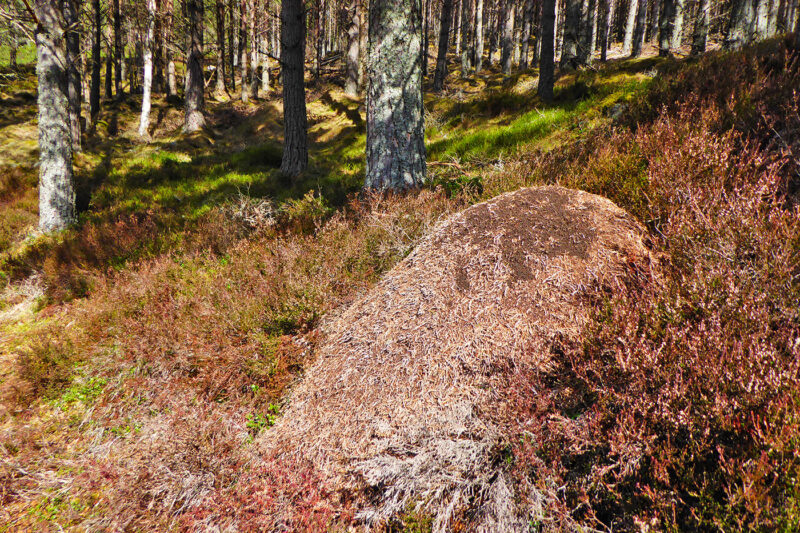
Other creatures of the pinewoods hog the media limelight – capercaillie, black grouse, red squirrel, pine marten, But ants deserve much higher billing on the pinewood stage, for they are, without doubt, one of the most fascinating creatures on the planet.
I crouch alongside for a closer look. There are thousands of ants swarming on the surface. I hesitate to describe them as tiny because yes, while all ants are tiny to our eyes, these ones are noticeably larger than your average ant.
Almost 1cm long, reddish in colour with a dark head and abdomen, these are at least twice as large as the small, black ants that undermine your garden paving slabs.
There are around 50 ant species in the UK, but the ones we’re focusing on here, the ones that are particular to Scottish woodlands and who construct large, obvious nests, are what are collectively known as wood ants.
There are two ‘true’ wood ants in Scotland. The Scottish Wood Ant is found across Europe and Asia, and its large nests are the archetypal domes. They are the most shade-tolerant of the wood ant species, but they do still need sunlight to warm the nest, so while you will find them deep in pine woodlands, they like the sunnier spots and glades.
The Hairy (or Northern) Wood Ant is superficially identical to the Scottish Wood Ant, so don’t be expecting something shaggy and hairy like a dog. However, if you have a hand lens, you’ll be able to see that while both the Scottish and Hairy species have fine hairs on their heads, in the latter they are more pronounced, and they have them on their thorax (waist).
Hairy Wood Ants have large nests too, although they tend to be less dome-like than the Scottish Wood Ant, with flatter summits. They are also less tolerant of shade than Scottish Wood Ants, and so tend to be found on the edges of woodland rather than the interior.
There are several related species as well, which I won’t go into here, but the Narrow-Headed ant is worth mentioning on account of its scarcity in the UK and the fact that the Cairngorms is its stronghold.
It has a distinctive notch at the back of its head, and it has much smaller nests – about 30cm high and containing only around 1000 individuals. The small size of the colony means it struggles to retain heat in the kind of locations where Scottish Wood Ants thrive, so is found in more open areas than the other two species: close to woodland, often in heathland, where direct heat is more readily available.
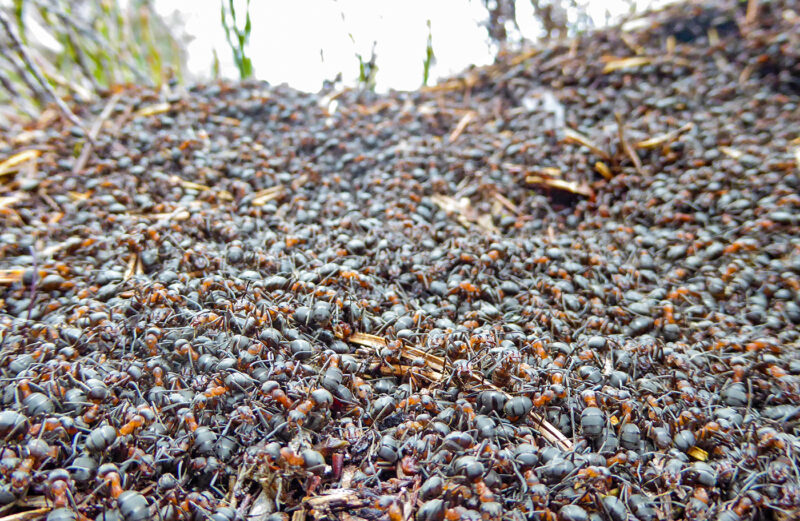
Ants are among the most numerous organisms on the planet, and in healthy Scottish woodlands, this is certainly the case. Each of these big brown ‘wood ant’ domes can be home to anywhere between 10,000 and 100,000 individuals, so it’s little wonder the nests are so big.
The largest wood ant nests can be up to 2m wide and 1.5m high above ground, but much of the structure continues below ground level too. Internally the nest contains a series of tunnels and chambers, in which you will find the ant queen, a nursery for the colony brood, and food stores. However, the only hint you’ll get of any internal structure is when the ants open the tunnel entrances on the surface.
The surface thatch is carefully constructed to maximise heat absorption, like a solar panel, but it also keeps the colony watertight. If you look closely, you will also see small yellow beads of pine resin in the thatch. These have antimicrobial qualities, and wood ants are known to incorporate them into the nest structure, to keep the colony free of fungal or bacterial infection.
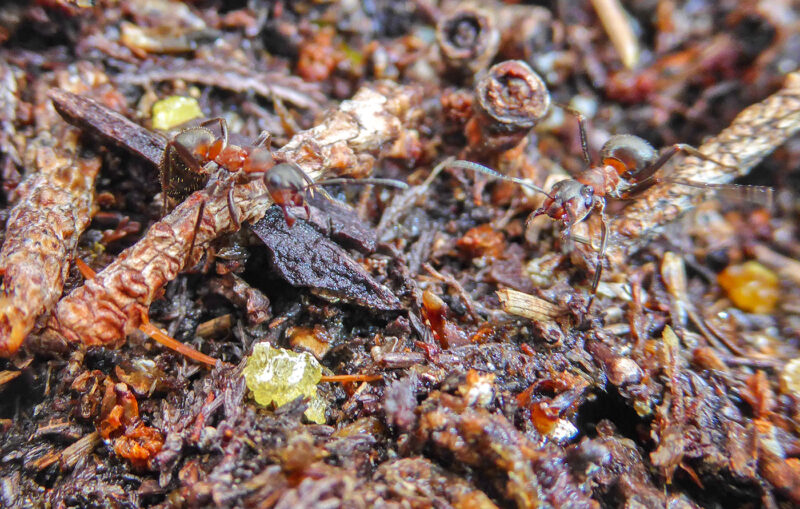
Wood ants are so numerous, and their impact upon their immediate environment so far-reaching, that they are rightly considered to be a ‘keystone’ species. That is to say, they have a disproportionately significant impact upon the rest of the ecosystem they inhabit, such that their removal would fundamentally change the way the whole ecosystem works. Remove the keystone from an archway, and the structure is weakened or can collapse.
In the process of constructing and maintaining their nests, ants inadvertently assist with the seed dispersal of plants, and their nests add minerals and organic matter to the soil, which helps with nutrient recycling in the forest.
The nests themselves are also home to other species besides ants, and as many as 100 invertebrate species are known to reside within them. Some peaceably, some not. Certain rove beetles for example, prey on the juicy ant larvae deep inside the nest. Intriguingly, they don’t elicit a defensive response from the ants because they mimic the smell of the colony, and the ants therefore don’t perceive them as a threat.
Other creatures, such as the Shining Guest Ant, are found only in the nests of wood ants. A quarter the size of wood ants, and with a distinctive shiny body, they occupy a small part of the nest and establish a colony within a colony.
Exactly what they get up to, and the extent to which they take advantage of their hosts, isn’t clear. Considering where they live, shining guest ants are little seen and little understood. That’s not surprising, given you have to sit at a wood ant nest at a certain time of day, at a certain time of year, getting swarmed by midges, in order to stand a good chance of seeing them. Considered rare, they are possibly under-recorded because such surveys clearly aren’t everyone’s idea of fun!
But the shining guest must be doing something to annoy its hosts, because they are routinely confronted. But these confrontations rarely come to anything because the shining guest ant tastes especially foul to the wood ants, who quickly disengage.
Wood ants are also food for other woodland inhabitants – green woodpeckers, badgers, black grouse, capercaillie. But they’re certainly no pushover, because both individually and collectively, wood ants can mount a formidable defence.
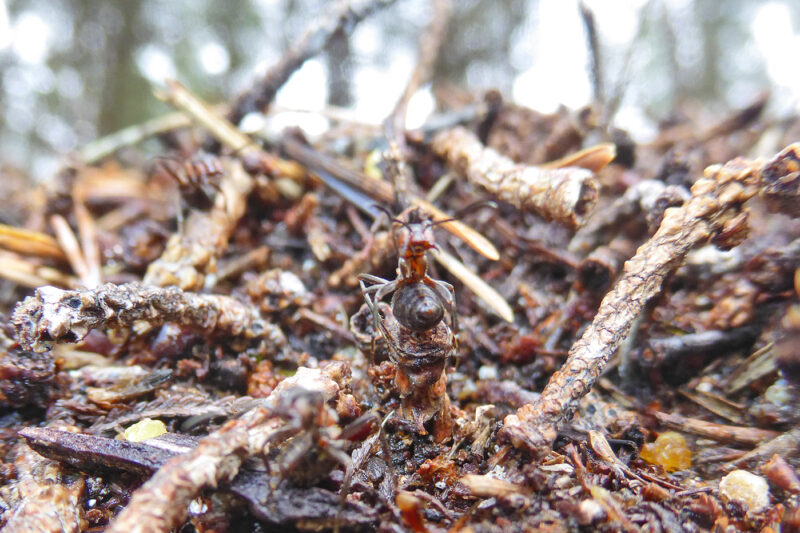
I’d never given much consideration to an ant’s defensive capabilities, not until I was climbing a big scots pine in Abernethy Forest once because…..well……why not? But there I was, 10ft up a tree, taking in the scene, when I felt a pinch on my hand.
For a moment I thought it hurt, but really it was just the shock and surprise. Instinctively I withdrew my hand and lifted it to my face to see what had nipped it. Quite unexpectedly, there was a large ant attached to my hand with its mouth, and its rear end flailing in the air.
It’s a lesson I’ve never forgotten. But even more formidably, wood ants can spray formic acid from their abdomens, across a distance of about 5cm. You can clearly see this when they’re threatened, as they bend their abdomens through their legs, and aim them at you.
It’s well documented that some birds, notably corvids, will land on nests and agitate the surface for this very reason. This encourages ants to spray acid, which kills parasites in the birds feathers.
These examples alone are all befitting of a keystone species, but above all, wood ants perform pest control on a humongous scale.
From the forest floor to the canopy above, up to 150 metres from the nest, the colony preys on a huge number of bugs and beasties. Potentially tens of thousands every day, which can benefit trees if those bugs and beasties would otherwise do the trees harm.
Spiders, flies, woodlice, beetles, caterpillars, and even ticks! There’s an interesting study from Switzerland, which documents a clear reduction in tick prevalence where there are healthy wood ant populations.
As with other social insects, such as wasps, it is the larvae in particular, back in the nest, who require all this protein. Much of the food the ants forage is much larger than they are, but ants are famously strong.
Quite how strong is open to debate. Go online and you’ll find a range of claims of how much of their own bodyweight they can lift: 2, 3, 7, 25, 50, 100.
Whatever! Clearly, ants are very strong for their size, which is obvious to anyone who’s ever spent just one minute watching ants go about their business. I never get tired, watching ants moving large objects such as pine needles, all by themselves. And indeed, the size of an object seems to have little bearing on how readily ants try to move it.
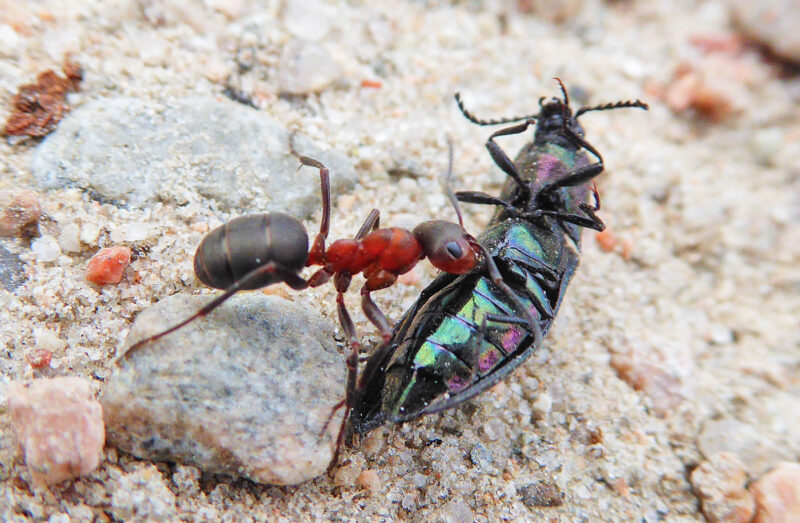
Last summer I watched a lone ant trying to move a dead peacock butterfly. It was never going to get it all the way back to the nest, but it was clearly able to wobble it about a bit. I sat there for ages, watching, because where ant strength is concerned, there’s always a bit of me that thinks….”well yep, maybe it can!”
But when they can’t subdue or move something individually, ants seek help from other workers. Teamwork is very much the ethos of the ant colony.
Important as all this protein is, most of the adult ants’ energy needs come from a downright bizarre source – tree sap that has passed through the bums of aphids.
Aphids, smaller than ants, pierce trees with their sharp mouthparts, and then drink the sugary sap within. Much of it passes straight through and emerges the other end as an excess product, high in sugar, called honeydew. Aphids naturally congregate around rich sources of sap, and the ants will protect them from predators (such as ladybirds) in return for a drink of honeydew. The ants will even herd the aphids to other more productive locations.
This close relationship with something akin to a grazing insect has led to a farming comparison, where the ants ‘farm’ the aphid livestock, ‘milking’ them to get what they need. Milking is done by tickling the aphids with their antennae, which stimulates production of honeydew.
The ants consume this themselves, but also regurgitate it when back in the nest, as food for colony and queen. This means the worker ants that are tending the broods and are unable to actively forage themselves, get fed.
The reason this vast harvest of food is foraged is, yes, to sustain the colony, but in particular it is to feed the larvae, which hatch out from eggs laid by the queen.
She, along with a significant number of her workers, has spent the long winter hibernating deep inside the nest, but must now begin laying eggs again.
This time of year, on these first milder days, the ants swarm onto the surface of the nest to warm their bodies up, which they need to do to become active.
Once warm, many of the ants will return into the depths of the nest, where their warm bodies will heat the nest from the inside. Given there can be anything between 10,000 and 100,000 ants in one of these nests, that’s a lot of heat being transferred from the exterior to the interior, powering the whole colony and keeping the eggs warm.
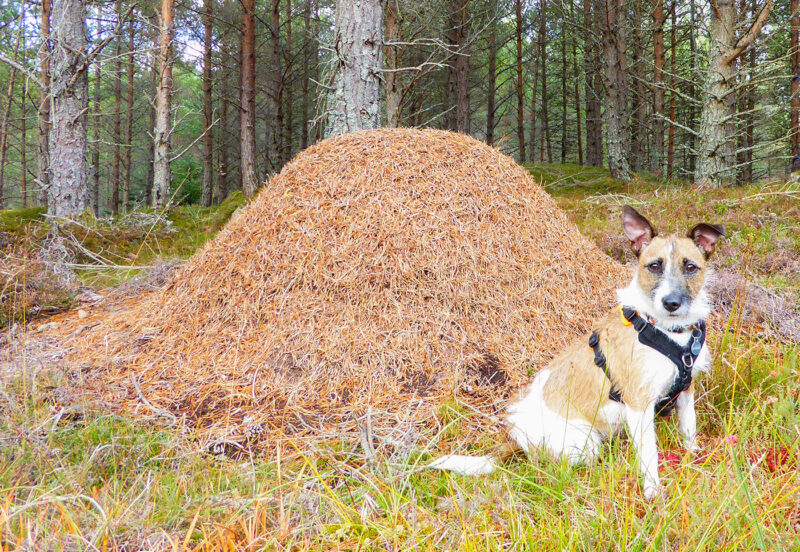
Wood ant nests are typically south-facing, and angled in such a way as to present the broadest face to the sunniest aspect. A wood ant nest’s optimum temperature is between 25C and 30C, but the colony can easily get too hot. If that happens, ants will open or close vents to the outside as and when required. A stable temperature benefits the whole colony, but especially the queen and her eggs.
The sex of the ants is determined by whether or not the queen fertilises her eggs. The vast majority of eggs ARE fertilised, using sperm the queen received when she mated.
The fertilised eggs hatch out into larvae, who are fed continuously until they pupate, ultimately undergoing metamorphosis and emerging as sterile, female adult ants. These females are the workers, and typically constitute all of the ants you see swarming around an ant nest.
This workforce is entirely dedicated to the upkeep and survival of the nest, and to do this they each have precise roles. Younger worker ants tend to be located inside, tending the queen and the brood of eggs, larvae and pupae. The workers move the eggs into the nursery, but they also move larvae around the nest to keep them in the optimum living conditions. The other workers get to forage outside.
Watching ants today, I’m thinking the same thing I always do – how on earth does each of them know exactly what they’re meant to be doing? Who tells them?!
Such questions blow my mind. Best not think about them really. So instead I just watch.
It can be difficult to focus on small details, because the busy, animated complexity of the assemblage distracts you. But it’s like one of those wonderful Richard Scarry cartoon books I had when I was a kid, where complex and busy scenes were drawn across two massive pages, and the joy lay in finding the smaller details and stories hidden within.
To that end, I like to focus on a single ant and just follow it as it goes about its business. Course, following a single worker ant, it’s not instantly apparent what her task or role is. But SHE knows!
Some of the larvae that hatch from the fertilised eggs are given special attention. A select few are fed an inflated, royal diet of the choicest cuts and, when these larvae pupate, they emerge as winged queens.
Quite how the workers know when and how to initiate this royal diet is something that utterly baffles me. But again, best not think about it. Instead, just marvel at the fact that it happens.
Later in the year, the queen will lay some unfertilised eggs. These become adult male ants, emerging from the nest in late summer. These are winged individuals who only appear for a short period, leaving the nest to mate with newly emerged queens.
The new queen ants also leave the nest to mate, which they will do just once in their lifetimes. After mating, the males have no other role in the colony and they die after a few short weeks.
The newly-mated queen then does one of several things. She might found her own nest by parasitising the nest of another species. She might return to her natal nest and live alongside her mother and sisters, albeit in a less dominant role than she’d have if she had her own nest. Or she might leave the natal nest with a band of workers to form a subsidiary or ‘satellite’ nest a short distance away, in a process known as ‘budding’.
There can be many satellite nests, each able to exchange resources and effectively functioning as single huge interlinked colony. So wood ant nests can have multiple, as well as single, queens.
The sperm that a queen receives during mating is kept in a specialised reproductive organ called a spermatheca, and she will use this to fertilise her eggs for the rest of her life.
And what a life it is!
Worker ants can live a few months. Longer, if they over-winter. But ant queens are among the longest lived of any insect. 15 years or more, for wood ants. Even longer for some species overseas.
This longevity, coupled with the fact that multiple queens of different ages can occupy one nest, means that individual ant nests can be amazingly long-lasting features within a landscape.

I was helping with a deadwood survey transect at Mar Lodge Estate in 2018, walking a 1km line in Glen Derry to precisely map and measure the deadwood distribution. The exact same survey gets done every ten years and therefore offers fascinating insights into how the woodland floor changes over time. At one location, we recorded an ant nest that had featured in both the 2008 and 1998 surveys, so it was at least 20 years old, but undoubtedly older even than that.
But 20 years is nothing when you consider that ants have been around for at least 100 million years. Scenes like the one before me, of ants swarming over a massive, socially constructed nest, have played-out for much longer than humans have been around.
That makes me feel small. And I, for one, think it’s wonderful that something so small can make me feel even smaller. Ants are, quite simply, amazing.
